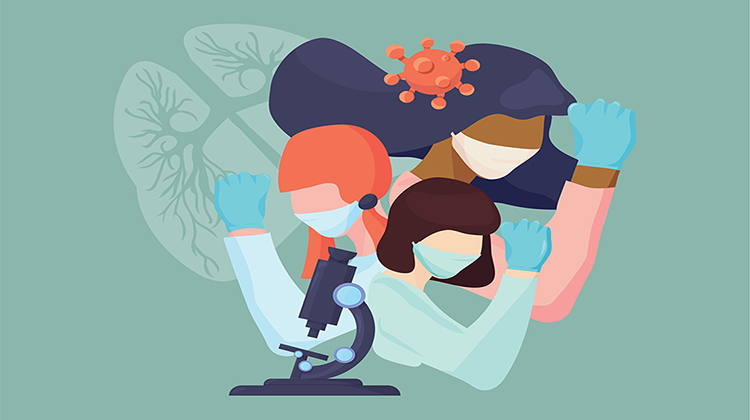Women in Stem with Morgane Rousselot
Posted: 3 July 2024 | Morgane Rousselot (SeaBeLife) | No comments yet
We had the privilege of speaking to Morgane Rousselot, co-founder and CEO of SeaBeLife for our Women in Stem series. With a strong scientific background and over two decades of entrepreneurial experience in the biotechnology field, she leads the company with a team-focused approach and intellectual rigor.


Can you tell us about your journey in the field of STEM and the challenges you encountered along the way?
My journey into STEM began at a young age. It was fuelled by my fascination with how the world operates and a deep desire to comprehend scientific phenomena. From high school onwards I chose to pursue studies in science; this passion has guided me throughout my academic journey. During my higher education, I faced various technical challenges, but I always strove to step out of my comfort zone and take on new challenges. I persevered with the support of mentors as I was determined to pursue my passion. With a predominantly industrial background, I attended an engineering school before embarking on a doctoral thesis in science. Throughout my career, I’ve had the opportunity to work on exciting research projects, collaborate with inspiring colleagues and contribute to significant scientific advancements. However, challenges persist, particularly in balancing professional and personal life as both a woman and mother, and the need to continue proving myself in a field that is often dominated by men. Despite these challenges, I remain passionate about my work and committed to encouraging more women to pursue careers in STEM. My journey has taught me the importance of resilience, perseverance, and self-confidence, and I take pride in contributing to a future where gender equality in STEM is the norm.
What inspired you to pursue a career in STEM, and how did you overcome any obstacles or biases you may have faced?
A combination of curiosity, passion for innovation and a drive to make a tangible impact in the world of biotechnology inspired me to pursue a career in STEM. From a young age, I was captivated by the intricacies of science and the potential it held for transforming lives. This fascination only deepened as I pursued my PhD in biochemistry, where I discovered how biology and chemistry can be used to address pressing healthcare challenges.
Throughout my career, I’ve encountered obstacles and biases, but my determination to succeed has always prevailed. As an entrepreneurial force in the biotechnology industry, I’ve faced skepticism and resistance from those hesitant to embrace disruptive technologies. However, I’ve learned to leverage these challenges into opportunities for growth, channeling my relentless drive and strategic mindset to overcome obstacles and push boundaries.
One of the key ways I’ve overcome biases is to lead by example and demonstrate the value of diversity and inclusion in driving innovation. By fostering a collaborative environment where diverse perspectives are valued and respected, I’ve been able to break down barriers and inspire others to embrace change.
Ultimately, my journey in STEM has been fueled by a fierce determination to succeed and a relentless drive to make a lasting impact in the field of biotechnology. I am committed to pushing the boundaries of what’s possible; driving innovation and leading teams towards groundbreaking discoveries that have the potential to transform healthcare and improve lives.
Could you share an example of a specific project or research that you have worked on and the impact it has had in your field?
I would like to share examples of two projects that have been instrumental in shaping my career and making a significant impact in the field of biotechnology.
Firstly, Hemarina holds a special place in my journey. It was the focus of my doctoral thesis, eventually leading to the co-founding of a startup. Hemarina’s groundbreaking work in developing universal oxygen carriers derived from marine invertebrates has revolutionised oxygen therapy. Through my involvement, from the early stages of research to the establishment of a startup and the subsequent clinical application of our product, I’ve witnessed first-hand the transformative power of scientific innovation in improving patient outcomes.
Secondly, SeaBeLife represents another milestone in my career. While not originating the research, I took charge of its development through a startup initiative. SeaBeLife’s focus on harnessing marine resources for biomedical applications has been both challenging and rewarding. My role involves steering the project towards clinical applications, leveraging my experience in entrepreneurship and strategic planning to accelerate its journey from lab to clinic. This project underscores my ability to identify promising research and translate it into tangible solutions for healthcare challenges.
In conclusion, both Hemarina and SeaBeLife exemplify my commitment to driving innovation and making a lasting impact in the biotechnology field. These experiences have shaped my approach to research and entrepreneurship, reinforcing my belief in the power of collaboration, perseverance, and ingenuity to advance healthcare and improve lives.
How has your research in STEM contributed to advancements or improvements in your field, and what potential future applications or implications do you foresee based on your work?
My research journey in STEM has contributed significantly to advancements and improvements in my field. For instance, in the Hemarina project, we developed universal oxygen carriers derived from marine invertebrates, providing an innovative solution for oxygen therapy. These oxygen carriers have the potential to revolutionise the management of transplantation, significantly improving conservation and limiting secondary effects. Additionally, in the SeaBeLife project, we explored the biotechnological applications of unique bioinspired molecules, paving the way for new possibilities in treating those severe diseases without effective treatment.
Regarding the future implications of my work, I foresee that research in these areas will continue to inspire new innovations and open up new therapeutic avenues. For example, in the field of universal oxygen carriers, advancements could have significant impacts on intensive care, surgical interventions and medical emergencies, providing new treatment possibilities for a wide range of patients.
In summary, my research in STEM has helped shape the landscape of biotechnology and has led to significant advancements in healthcare. I am confident that these efforts will continue to generate promising progress and offer new solutions to address current and future medical challenges.
As a woman in STEM, what unique perspectives or strengths do you believe you bring to your work?
As a woman in STEM, I believe that I bring unique perspectives and strengths to my work. Firstly, my experiences as a woman navigating the STEM field have given me insights into the challenges and barriers that women often face in male-dominated environments. This perspective has heightened my awareness of the importance of diversity and inclusion in driving innovation and problem-solving.
Additionally, research suggests that women tend to approach problem-solving and collaboration differently than their male counterparts. I believe that my collaborative approach, combined with strong communication skills and empathy, allows me to foster inclusive environments where diverse ideas are valued and respected. This ultimately leads to more creative solutions and better outcomes for our projects.
Furthermore, my journey as a woman in STEM has taught me resilience, perseverance, and adaptability in the face of adversity. These qualities enable me to thrive in challenging environments and to overcome obstacles with determination and grace.
Overall, I believe that my unique perspectives, collaborative approach, and resilience as a woman in STEM contribute to the richness and effectiveness of our team’s work, driving innovation and excellence in our field.
What advice would you give to young women who are considering a career in STEM but may be hesitant due to societal stereotypes or perceived challenges?
To all young women considering a career in STEM but hesitant due to societal stereotypes or perceived challenges, I would say this: do not let obstacles discourage you, know that they will help you grow. You have the right and the potential to succeed in any field you choose. Persistence is key.
Firstly, do not underestimate your skills or your worth. You have as much ability as anyone else to succeed in STEM if that is what you deeply desire, and your voice and ideas are valuable.
Secondly, seek out role models and mentors who can support you on your journey. Finding women who have succeeded in STEM can help you see the possibilities and gain valuable advice to overcome challenges.
Next, do not be afraid to fail. Failure is an integral part of the learning and growth process. Use your failures as opportunities for learning and development.
Lastly, remain passionate and persistent in your pursuit. STEM offers exciting opportunities and stimulating challenges. By staying determined and working hard, you can achieve your professional dreams and contribute to shaping a better future for everyone.
How do you see the representation of women in STEM changing over the years, and what further progress do you believe is needed?
I see a positive evolution over the years in the representation of women in STEM, particularly with an increasing acceptance of women in leadership positions. Attitudes are changing, especially among younger generations, who are increasingly exposed to strong female role models in senior management. However, despite these advancements, challenges persist, especially with older generations where leadership positions are still often held by men.
It’s encouraging to see more women choosing careers in STEM, but we need to continue working to increase their representation at all levels, including in leadership and research positions. This requires promoting a culture of inclusion and equal opportunities, as well as fair recruitment and promotion policies.
Additionally, I am concerned about the growing trend of positive discrimination, which, while well-intentioned, can sometimes go against the principle of meritocracy. It’s important to strike a balance and promote approaches that recognise and reward women’s skills and achievements regardless of gender.
To further progress, we need to continue actively encouraging and supporting women in their STEM career paths, with a focus on creating inclusive and diverse work environments. It’s also crucial to invest in educational programs that encourage women of all ages to pursue studies and careers in these fields.
In summary, while progress has been made, it’s necessary to continue working to ensure equitable representation of women in STEM and to create environments where they can thrive and contribute fully to innovation and discovery in these fields.
In your opinion, what can organisations and institutions do to create a more inclusive and supportive environment for women pursuing STEM careers?
I believe there are several measures that organisations and institutions can take to create a more inclusive and supportive environment for women pursuing careers in STEM.
Firstly, it’s essential to promote a top-down culture of inclusion in all organisations. Leaders should be champions of diversity and equal opportunities, committed to creating an environment where women feel valued and respected.
Secondly, it’s important to implement fair recruitment and promotion policies and practices. This means closely examining recruitment processes to eliminate unconscious biases and ensuring that women have the same advancement opportunities as their male counterparts.
Additionally, organisations can offer mentoring and professional development programs specifically designed to support women in their STEM career paths. These programs can provide crucial support, guidance and networking opportunities to help women succeed and advance in their careers.
Furthermore, creating a flexible and inclusive work environment is important; one that allows women to balance their professional and personal responsibilities. This may include policies such as remote/hybrid work, flexible working hours and paid parental leave.
In summary, to create a more inclusive and supportive environment for women in STEM careers, organisations and institutions need to commit to promoting a culture of inclusion, implementing fair policies and offering support and professional development opportunities for women throughout their careers.
Looking ahead, what exciting developments or advancements do you foresee in your field of STEM, and how do you envision your own research contributing to those future innovations?
I am convinced that in the years to come, we will witness extraordinary developments in the field of STEM, particularly due to the rise of emerging technologies such as artificial intelligence, biotechnology and personalised medicine.
In my own field of biotechnology, I anticipate major advancements in regenerative medicine. With cutting-edge techniques, we will be able to develop more precise, rapid and effective treatments for a diverse range of degenerative diseases.
Regarding my own research, I am excited about the potential to contribute to these future innovations. By continuing to explore the unique properties of bioinspired molecules the SeaBeLife project has discovered, I am confident that we can develop new drugs and therapies that push the boundaries of modern medicine.
Furthermore, by closely collaborating with researchers and experts from various STEM fields, I am confident that we can fully harness the potential of new technologies to advance research and develop innovative solutions to the most pressing health challenges of our time.
In summary, I am optimistic about the future of my STEM field and convinced that my own research will play an important role in achieving future advancements and innovations. By continuing our commitment to scientific excellence and innovation, I believe we can transform how we treat diseases and improve the lives of millions of people worldwide.
About the author
Dr Morgane Rousselot, co-founder and CEO of SeaBeLife


With a strong scientific background, including a PhD in biochemistry and a degree in chemical engineering, Morgane brings to SeaBeLife over two decades of entrepreneurial experience in the biotechnology field. Her career is marked by numerous publications and patents. In 2007, she co-founded Hemarina, a pioneer in marine therapeutic oxygen carriers. In 2015, Morgane became vice-president at Tolerys, specialising in immunotherapy. Her passion for innovation led to her co-founding SeaBeLife in 2019, a biotechnology company dedicated to treating multiple severe diseases by blocking cellular necrosis. As CEO, she leads the company with a team-focused approach and intellectual rigor. Recognised as a leading female entrepreneur by L’Usine Nouvelle in 2022, she was also honored with a knighthood from the French National Order of Merit in 2023. Her journey reflects her commitment to scientific research, entrepreneurship and leadership in the pursuit of innovative health solutions.
Related topics
Therapeutics
Related organisations
SeaBeLife
Related people
Morgane Rousselot (SeaBeLife)







